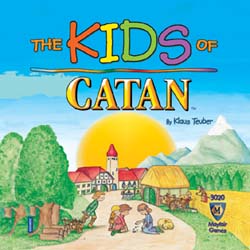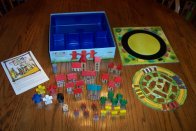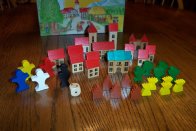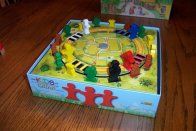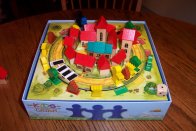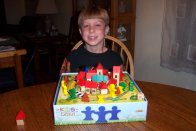
|
Kids of Catan A game by Klaus Teuber Published by Mayfair Games, Inc. and Kosmos Players: 2 to 4 Time: 20 minutes Reviewed by Susan Rozmiarek |
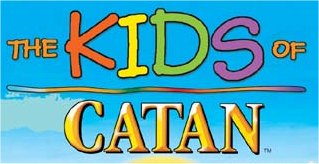
|
The Settlers of Catan board game has enjoyed enormous popularity. It has spawned many expansions, variants, a card game version, and even a travel edition. So, it comes as no surprise to see a new version for younger players, Kids of Catan.
The theme of Kids of Catan ties directly into that of the parent game. Some children are collecting various resources, wood, grain and brick, and hauling them back in their carts in order to help their parents build a village on the island of Catan. They are hindered in their task by one of the children's older brother, Erik, who frightens them away and then steals from their cart as a game. This is all explained very nicely in a cute, illustrated story at the beginning of the rules.
Components:
Rulebook: A small, eight-page booklet containing the story mentioned above and very clear, concise rules with numerous color illustrations. An online tutorial in English can also be found at www.klausteuber.com/kidsofcatan.
Buildings: There are thirteen buildings made from wooden blocks, of various shapes and types, including a school, church, and Town Hall. These are of top-notch quality, with painted roofs, doors and windows.
Pawns: Wooden player pawns in four colors and a black, differently shaped pawn for Erik, the robber.
Resources: Five of each of the three resources, wood, wheat, and brick in different shapes and colors for the resource they represent.
A large six sided wooden die with pips from one to three.
A plastic insert for the box with separate compartments for the components.
A game board and turntable: This is a really clever mechanism that utilizes the box and plastic insert. The board fits on top of the insert exactly and the round turntable sets on the top of it. A large wooden pin (included) is inserted through holes in the center of both and into a well in the insert underneath. This creates a turntable that spins freely.
Game play:
The board/turntable depicts the village in the center, with slots of various sizes in which the different buildings are placed as each is built. Around this in a circle are carts, one for each player. Each has a slot in which the player's pawn is placed and three slots for resources. The player pawns must be tilted sideways to be placed in the slot. As a small quibble, this might prove difficult for a child to do at first. Once placed, the pawn is used for turning the turntable easily. The village and carts are on the part of the board that moves. Resources and the robber are placed in color-coded spaces on the outermost fixed part of the board, circling the carts and village. This is another minor quibble. The resources, and in particular, the robber, were occasionally bumped and knocked over during play.
The red-roofed buildings are divided evenly among the players and the green-roofed Town Hall is set aside. The game is now ready to begin.
On a player's turn, she rolls the dice and carefully moves her cart the number of spaces depicted on the die. Since the whole turntable moves, the other players' carts will move as well. Now ALL players look to see if their pawn is next to a resource. If so, they may take that resource and place it in their cart, provided they do not already have a resource of that type. If their pawn is not next to a resource they do not get anything.
This mechanism is one of the strengths of the game. Young children are easily bored waiting for their turn. Here they are actively involved in everybody's turn.
If a player's pawn lands next to Erik, the robber, he steals one of the resources in the player's cart. The player chooses one of her resources and places it back on any empty spot.
As soon as any player has filled her cart with one each of the three resources, she may trade these in, and "build" one of her buildings. She chooses any of her buildings and finds a matching slot, by size, in the villager and places it there. The resources used are placed back on matching empty slots on the board. It is only in the placement of resources, here and when Erik steals one, that there is a bit of strategy. If possible, a player should place the resource close to her and/or far away from players who need it
When a player has finished building all of her buildings, she may build the Town Hall for the same cost of three resources. The first player to build the Town Hall is the winner. Some children may enjoy just playing this as a cooperative effort to build the village without declaring a winner.
Comments:
This game is essentially of the roll-and-move variety that is often found in games for young children. There are very few decisions to be made and adults and older children will probably find the game itself dull. The fact is, there are basic fundamentals a child must learn before being ready to tackle the more complicated games which older players find interesting. Taking turns, following rules, and accepting defeat graciously are a few of these. When a child masters these is different for each individual. Although the box suggests the game for ages four and up, some three-year olds will be able to handle it. It is worth noting that some of the pieces are small enough to be choking hazards. I did try the game with a few 6 and 7 year olds, but they quickly got bored. I think the game works best with children in the 3-5 year old range. The rules do encourage free play and suggest players come up with their own rules. However, it would have been nice if rules for more strategic play for older children had already been included. I do notice that someone has posted such a variant at BoardgameGeek, although I have not tried it.
Despite its limitations, the game does shine in several ways when looking at the game from the standpoint of its targeted younger audience:
-
Toy-like components: As anyone who has tried to play a game with a very young child knows,
they are often more interested in playing WITH the game.
Sturdy, interesting components are a must.
It is here that Kids of Catan gets very high marks from me.
The chunky pieces are perfect for little hands.
The bright, cheerful colors and art are very appealing.
Children will enjoy imaginative play with the pieces - setting up the village, filling their carts, turning the turntable, etc.
- Educational game play: The rules are simple and good for developing the skills of taking turns and following rules. Beginning color matching, size matching and simple counting are all incorporated in the play. Basic set-collecting and trading is there as well. And best of all, players stay involved in each other's turns, which helps with short attention spans.
Summary:
Kids of Catan is obviously intended for young children, about 3-5 years in age,
and will not be of much interest to just older players.
It will also be outgrown rather quickly without some variants added.
That said, it is excellent for beginning gamers who will find the game fun,
while learning many basic skills necessary for advancing to more challenging games.
It is a much better choice than many of the other games available for this age group.
I wish it had been around when my own children were younger.
Other Web information:
This page viewed
E-mail Ed Rozmiarek with questions or problems concerning this page.
Copyright © 2004, Ed & Susan Rozmiarek
